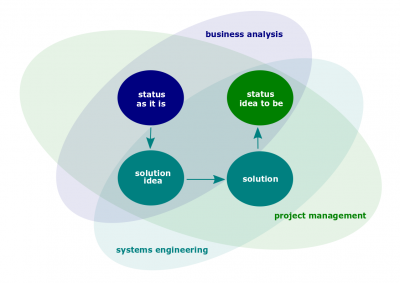Systems engineering
Systems engineering (also known by its abbreviation; hereinafter, SE) is the orderly process of bringing a system into being using a systems approach.
Key points
- Systems approach. The application of a systematic disciplined engineering approach that considers the system as a whole, its impact on its environment and continues throughout the lifecycle of a project.
- Ergonomics (human factors). The scientific discipline of studying interactions between humans and external systems, including human-computer interaction. When applied to design, the study of human factors seeks to optimise both human well-being and system performance.
- Datapoint-device architecture.
- Object-oriented modeling. An approach to software engineering where software is comprised of components that are encapsulated groups of data and functions which can inherit behavior and attributes from other components; and whose components communicate via messages with one another. In some organizations, the same approach is used for business engineering to describe and package the logical components of the business.
Lexicon
- Abstraction. The ability of engineers to think of design concepts that are not dependent on specific solutions.
- Boundary. A separation between the interior of a system and what lies outside.
- Context. The users, other systems and other features of the environment of the system that the system will interact with.
- Customer. The organization or individual that has requested (and will pay for) a product or service.
- Engineering. The application of scientific principles to practical ends.
- Feedback. Information about the output of a system that can be used to adjust it.
- Gantt Chart. A project management tool in the form of a bar chart showing the start and finish dates of activities.
- Input. A material, service or support item that is processed by the system.
- Interdisciplinarity. People from different disciplines working together to design systems.
- Lifecycle. Important phases in the development of a system from initial concept through design, testing, use, maintenance, to retirement.
- Mission. An undertaking that is supported by the system to be designed to be successful (e.g. space mission).
- Optimization. The process of choosing the best alternative that will satisfy the needs of the stakeholders under the constraints given (e.g. cost, schedule and available technology).
- Output. What is produced by a system.
- Process. A set of activities used to convert inputs into desired outputs.
- Project. An activity having goals, objectives, a beginning and an end.
- Requirement. A statement of required behavior, performance and other characteristics of the system to be developed.
- Risk Management. A process of identifying what can go wrong and making plans that will enable a system to achieve its goals.
- Specifications. The technical requirements for systems design.
- Stakeholder. An individual or group affected in some way by the undertaking. Stakeholders are valuable sources for requirements.
- System. A set of interrelated components working together to produce a desired result.
- Systems Approach. The application of a systematic disciplined engineering approach that considers the system as a whole, its impact on its environment and continues throughout the lifecycle of a project.
- System Design. The identification of all the necessary components, their role, and how they have to interact for the system to fulfill its purpose.
- System Integration. The activity of integrating all the components of a system to make sure they work together as intended.
- Systems Engineering. The orderly process of bringing a system into being using a systems approach.
- Trade-off. losing one quality or aspect of something in return for gaining another quality or aspect.
- Value. The benefit enjoyed by the stakeholders of the system when the system is in operation.
- Validation. Testing to insure that the created system actually provides the value intended to its stakeholders. (Did we build the right system?).
- Verification. The process of proving that a finished product meets specifications and requirements. (Did we build the system right?)
